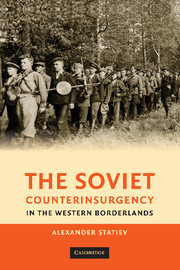Book contents
- Frontmatter
- Contents
- List of Figures
- List of Tables
- Acknowledgments
- Glossary
- Introduction
- 1 Origins of Soviet Counterinsurgency
- 2 The Borderland Societies in the Interwar Period: The First Soviet Occupation and the Emergence of Nationalist Resistance
- 3 The Borderlands under German Occupation (1941–1944): Social Context of the Soviet Reconquest
- 4 Nationalist Resistance after the Soviet Reconquest
- 5 Soviet Agrarian Policy as a Pacification Tool
- 6 Deportations, “Repatriations,” and Other Types of Forced Migration as Aspects of Security Policy
- 7 Amnesties
- 8 Red Rurales: The Destruction Battalions
- 9 Police Tactics: Actions of NKVD Security Units, Intelligence Gathering, Covert Operations, and Intimidation
- 10 The Church in Soviet Security Policy
- 11 Violations of Official Policy and Their Impact on Pacification
- 12 Conclusion: Nationalist Resistance and Soviet Counterinsurgency in the Global Context
- Appendix A Note on Used Terms and Geographic and Personal Names
- Appendix B Note on Primary Sources
- Bibliography
- Index
2 - The Borderland Societies in the Interwar Period: The First Soviet Occupation and the Emergence of Nationalist Resistance
Published online by Cambridge University Press: 05 May 2010
- Frontmatter
- Contents
- List of Figures
- List of Tables
- Acknowledgments
- Glossary
- Introduction
- 1 Origins of Soviet Counterinsurgency
- 2 The Borderland Societies in the Interwar Period: The First Soviet Occupation and the Emergence of Nationalist Resistance
- 3 The Borderlands under German Occupation (1941–1944): Social Context of the Soviet Reconquest
- 4 Nationalist Resistance after the Soviet Reconquest
- 5 Soviet Agrarian Policy as a Pacification Tool
- 6 Deportations, “Repatriations,” and Other Types of Forced Migration as Aspects of Security Policy
- 7 Amnesties
- 8 Red Rurales: The Destruction Battalions
- 9 Police Tactics: Actions of NKVD Security Units, Intelligence Gathering, Covert Operations, and Intimidation
- 10 The Church in Soviet Security Policy
- 11 Violations of Official Policy and Their Impact on Pacification
- 12 Conclusion: Nationalist Resistance and Soviet Counterinsurgency in the Global Context
- Appendix A Note on Used Terms and Geographic and Personal Names
- Appendix B Note on Primary Sources
- Bibliography
- Index
Summary
One momentary blow delivered to Poland by the German Army and later by the Red Army was sufficient to smash this ugly offspring of the Versailles Treaty that existed at expense of non-Polish nationalities.
– Viacheslav Molotov, People's Commissar of the Foreign Affairs of the Soviet UnionDuring the Revolution and the civil war, Russia lost many of its western provinces. Estonia, Latvia, Lithuania, and Finland each declared independence in 1917–1918, whereas Poland and Romania took advantage of the turmoil in Russia to appropriate adjacent territories. When Hitler offered the Soviet Union a nonaggression pact in August 1939, Stalin sensed an opportunity to return these lands. On 23 August, Germany and the Soviet Union concluded a pact that divided eastern Europe between them, and a week later, Germany attacked Poland, thus triggering World War II. After the Polish Army virtually disintegrated, Germans surrounded Warsaw and reached the demarcation line set by the Nazi-Soviet pact, the USSR invaded Poland from the east on 17 September. By July 1940, it absorbed most of the former imperial possessions. This chapter analyzes the rural societies of eastern Poland and the Baltic States in the interwar period, outlining the strains they experienced and discussing how the Soviet government attempted to exploit those strains after it occupied those regions. Soviet reforms found some support among borderland people but did not take root before the German attack and the repressions provoked the growth of anti-Communist resistance.
- Type
- Chapter
- Information
- The Soviet Counterinsurgency in the Western Borderlands , pp. 35 - 52Publisher: Cambridge University PressPrint publication year: 2010



